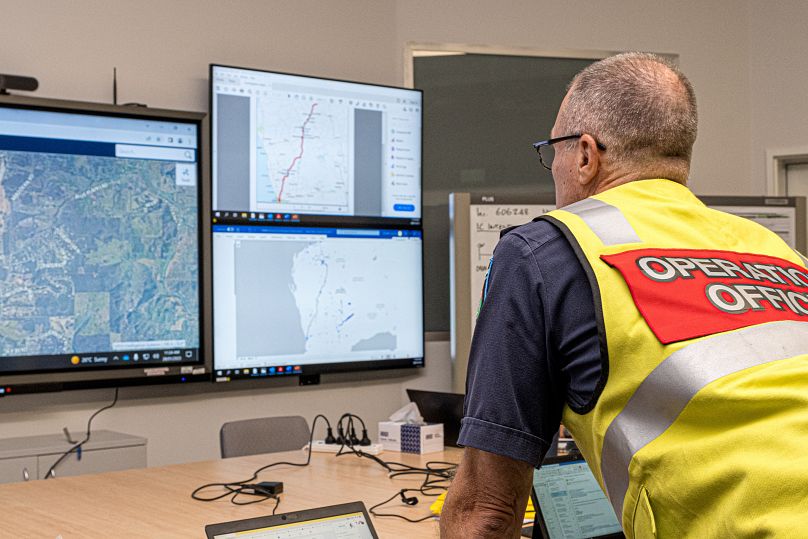Authorities in Western Australia have found the missing radioactive capsule. But how did it go missing and what danger did it pose?
A tiny radioactive capsule that went missing last week somewhere in the desert in Australia has finally been found after a huge search effort was launched.
Announcing its discovery, authorities in Western Australia said they had "literally found the needle in the haystack".
The missing silver capsule was just 8mm by 6mm, and was believed to have fallen from a truck that travelled 1,400 km along Western Australia. Its loss triggered a radiation alert for large parts of the state.
Authorities said on Monday it would take five days to retrace the truck’s route. On Tuesday, they said that 660 km had been searched so far, and that a team from the country's nuclear safety agency had now joined the hunt.
How could this happen, and how dangerous was this capsule? Here’s what you need to know.
How did the radioactive capsule get lost?
The capsule is believed to have fallen from a truck with multiple trailers driving down the red roads of the Western Australian desert towards the city of Perth, sometime between January 12 and January 16.
Authorities suspect the capsule, part of a gauge used in mining equipment, fell out of its casing after vibrations from the bumpy roads caused screws to come loose.
The truck left on January 12, and the casing arrived in the suburbs of Perth on January 16. But it wasn’t until nine days later, on January 25, that it was unpacked by mining giant Rio Tinto for inspection - and the loss of the capsule became clear.
Western Australia’s authorities alerted the public of the disappearance on January 27, two days after they were notified by Rio Tinto.
It sounds like the opening sequence of an apocalyptic film where catastrophes are often triggered by the smallest of incidents. But the risk posed by this missing radioactive capsule was very real.
Radiation specialists had been searching the Great Northern Highway for the tiny capsule by "driving north and south directions at slow speed," to no avail, Western Australia’s Department of Fire and Emergency Services said on Monday.
People in the state had also been warned that the capsule may have unknowingly become lodged in their car’s tires - and thus travelled even further.
Rio Tinto has said it’s “sorry” for causing public concern and that it’s taking the incident very seriously.
What is this radioactive capsule for?
Experts relied on radiation detection equipment to find this silver capsule, which is smaller in diameter than a 1 euro cent coin and looks a bit like a button battery.
It’s a 19-GBq (which stands for gigabecquerel, a unit indicating radioactive decay) caesium-137 ceramic source, the sort typically used in radiation gauges. These devices use radioactive sources to measure parameters like thickness, density and moisture of different materials and surfaces to allow the construction of safe buildings, roads, and other projects.
Capsules like the one that has gone missing are usually employed in the mining, oil and gas industries.
The caesium-137 contained in the capsule is a radioactive metal which emits dangerous beta and gamma radiation.
Its half-life is of 30.05 years, meaning it takes that long for the metal to lose half of its original activity. It is encapsulated by steel which prevents the radioactive material from escaping.
How bad is it that the capsule has gone missing?
Its disappearance was pretty bad, according to authorities. The capsule emits dangerous amounts of radiation that could cause skin burns, while prolonged exposure could cause cancer.
Spending an hour one metre from the missing capsule would be similar to undergoing 10 X-rays, officials have warned.
Radiation Services WA said it might be even worse, estimating the radiation dose from the capsule to be equal to 17 chest X-rays.
Beyond exposure, there’s also a risk of contamination. If the missing capsule was to be broken, the beta particles contained inside it would cause serious damage to people’s health should they get in touch with it or ingest it.
A radiation alert was issued across parts of the Australian state and members of the public had been advised to stay at least five metres away from the radioactive capsule if they happen to find it.
The risk to the general community was deemed to be low, but the loss of the highly radioactive capsule along the Western Australian desert has raised significant alarm in the area - and put a spotlight on Rio Tinto.
The global mining group came under fire in 2020 for destroying a site of sacred importance for Indigenous Australians while expanding an iron ore mine.
The mining giant has now apologised for losing the tiny capsule.
"We recognise this is clearly very concerning and are sorry for the alarm it has caused in the Western Australian community," Simon Trott, Rio Tinto’s iron ore division chief, said in a statement on Monday.
Meanwhile, the hunt for the missing radioactive material continues.












